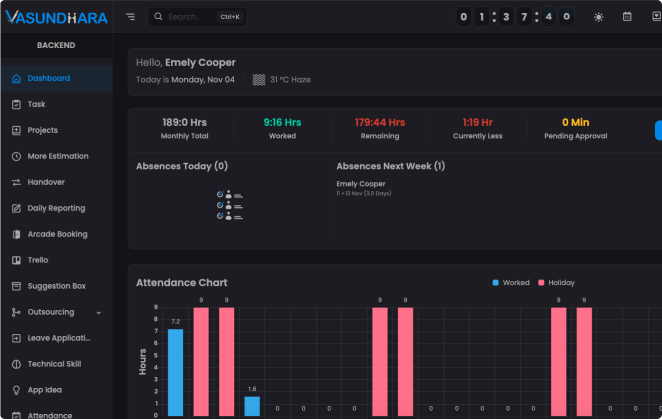This case study presents the implementation and success of a cutting-edge Human Resource Management System (HRMS) software, conceptualized and developed by Vasundhara Infotech, aimed at revolutionizing HR operations within an organization. The software addresses the challenges faced by HR professionals by providing a comprehensive solution that enhances efficiency, streamlines processes, and improves overall organizational performance. The objective was to create a new system for employee management, performance monitoring, and business administration.


Prior to implementing the HRMS software, the HR department encountered several challenges, including:
 Time-consuming and error-prone manual processes for employee data management, leave applications, and attendance tracking.
Time-consuming and error-prone manual processes for employee data management, leave applications, and attendance tracking. Fragmented communication channels leading to miscommunication and delays.
Fragmented communication channels leading to miscommunication and delays. Inefficient task management and lack of visibility into project statuses.
Inefficient task management and lack of visibility into project statuses. Difficulty in identifying and tracking employee skills and competencies.
Difficulty in identifying and tracking employee skills and competencies. Limited employee engagement and involvement in the organizational decision-making process.
Limited employee engagement and involvement in the organizational decision-making process.An advanced HRMS software was introduced to address various HR challenges, encompassing comprehensive features and functionalities for seamless employee management, integrated leave system, and project management.
The software provided an intuitive dashboard offering attendance charts and total working hours including monthly total hours, total hours worked, remaining hours, currently less hours and pending hours for approval, enabling HR professionals to monitor and manage operations effectively.
Comprehensive employee profiles were maintained within the software, allowing HR professionals to efficiently manage employee information, track training and development, and support talent management initiatives.
The software streamlined the leave application process, enabling employees to request and manage their leaves conveniently, while HR professionals could efficiently track and approve requests.
Efficient task and project management modules allowed HR professionals to assign, track, and prioritize tasks, ensuring timely completion and improved productivity.
Seamless handover of responsibilities during employee transitions was facilitated through the software, ensuring knowledge transfer and minimizing disruption.
The HRMS software featured a suggestion box module, encouraging employees to contribute ideas and suggestions for process improvement, fostering a culture of innovation.
The software provided a platform to manage outsourcing projects, including vendor selection, contract management, and performance tracking.
Employees could submit their app ideas through the software, providing a channel for innovation and potentially valuable additions to the organization's product portfolio.
HR professionals could track and update employee technical skills within the software, facilitating better resource allocation and identifying skill gaps for training purposes.
The software included a gallery feature to showcase employee achievements, fostering a culture of recognition and boosting employee morale.
An efficient ticket system within the software facilitated issue tracking and resolution, ensuring timely and effective problem-solving.
The HRMS software allows HR professionals as well as employees to manage and organize calendar events, facilitating efficient scheduling and coordination.
Integration with existing libraries enabled easy access to HR resources and employees, promoting knowledge sharing and collaboration.
The HRMS software incorporated various features to enhance employee engagement, such as a suggestion box, app idea submission platform, and an employee recognition gallery, promoting a collaborative and innovative work environment.
An integrated performance evaluation module facilitated fair and transparent performance assessments, aligning employee goals with organizational objectives and fostering professional growth.
HR professionals could track and manage PC and place arrangements through the software, ensuring efficient allocation and utilization of resources.
The software facilitated the management of device inventory, tracking ownership, availability, and allocation of devices within the organization.
The HRMS software ensured compliance with privacy policies and data protection regulations, safeguarding sensitive HR information.
The software provided regular update logs and notifications to keep HR professionals and employees informed about system changes, new features, and important updates.
The development process involved the following stages:

The objective was to create a new system for employee management, performance monitoring, and business administration. For security purposes, the software had to provide role-based user access for various positions, such as HR manager, CEO, Operations Manager, and others. The implementation of the HRMS software presented a number of challenges as the following:
 Resistance to change
Resistance to change Employee assimilation of the new system
Employee assimilation of the new system Integration with existing HR systems and processes
Integration with existing HR systems and processes Data security and compliance with privacy policies
Data security and compliance with privacy policies Training employees to effectively use the software.
Training employees to effectively use the software.
The primary goals of implementing the HRMS software were as the following:
 Streamline HR processes
Streamline HR processes Reduce manual efforts
Reduce manual efforts Improve communication and collaboration between HR and employees
Improve communication and collaboration between HR and employees Increase employee engagement and satisfaction
Increase employee engagement and satisfaction Enable data-driven decision-making through comprehensive reporting and analytics.
Enable data-driven decision-making through comprehensive reporting and analytics.
The successful implementation of the HRMS software transformed HR operations within the organization by addressing key challenges, streamlining processes, and enhancing overall efficiency. The exhaustive features and robust reporting and analytics capabilities of the software delivered tangible benefits, such as increased employee engagement, enhanced communication, increased productivity, and improved decision-making. In a rapidly evolving business environment, the organization can now effectively manage HR tasks, foster employee development, and adapt to changing HR requirements.
Copyright © 2025 Vasundhara Infotech. All Rights Reserved.